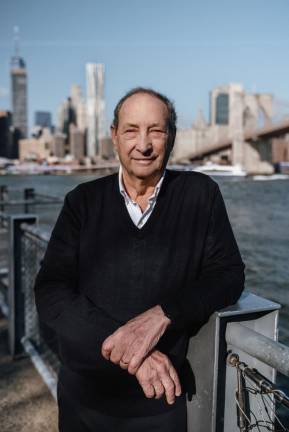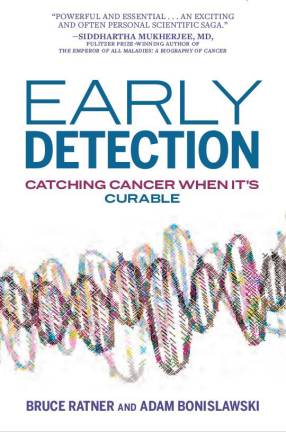Heartbreak After Brother’s Death Spurs Book Urging More $$$s for Early Cancer Detection
Rocked by a personal family tragedy, real estate developer and philanthropist Bruce Ratner, who is on the board of Memorial Sloan Kettering and Weill Cornell Medical College, resolved to write a book on the importance of the early detection of cancer. “Early Detection” hits May 7th.
After his older brother died in 2016 from metastatic brain cancer, Bruce Ratner made the decision to work on his book “Early Detection: Catching Cancer When It’s Curable,” which will be released on May 7.
”I’ve been working on the book since the day my brother died,” said Ratner, whose brother, Michael, a well-known civil rights attorney, passed away only eight months after he was diagnosed.
Along with his co-author, science writer Adam Bonislawski, Ratner interviewed over 100 subjects from doctors, scientists and corporations to the National Cancer Institute, Center for Disease Control and the Federal Drug Administration. In the book, he explains that research money is focused on the treatment of advanced cancers and in 2021 alone, NCI spent only nine percent of its $6.4 billion budget on detecting the disease. When asked what he hoped readers would take from it, he said, without hesitation, “Get screened, today, tomorrow and forever.”
Ratner’s impressive resume includes serving as the consumer affairs commissioner under Mayor Ed Koch and co-founding Forest City Ratner, a real estate development company responsible for building the New York Times Building, the Barclays Center and Brooklyn’s MetroTech complex among other massive projects. He also sits on the board of Memorial Sloan-Kettering Cancer Center and Weill Cornell Medical College.
Tell us about your personal connection to cancer.
All my life, I’ve had interest in science and in college, I took math, business and biology courses and I followed science for most of my life. I’ve been fortunate to be on the board of Sloan Kettering for two decades and Weill Cornell Medicine for two decades and the Cold Spring Harbor Laboratory, which is a research organization. And I’m one of those board members who follows the science and so I know a decent amount for a layperson about cancer. And then the person probably closest to me in my life was my older brother, he was a well-known human rights lawyer. We were inseparable. And I was out West and get a call from him saying that he’s sick to his stomach and I said, “Why don’t you go to Weill Cornell and talk to the infectious disease person?” The next morning, I hear he’s in the emergency room and they’ve taken a CT scan and found a brain tumor. I get on the next plane and come back and the bad news is, it was a metastatic brain tumor from somewhere else in his body. There was a disease called leptomeningeal disease, which is when the cancer travels to your spinal fluid and you have a couple of months to live. He wound up being at Sloan Kettering and they gave him an experimental drug created for the particular mutation he had. And he lived for about eight more months and I was so glad to have him for eight months. On the other hand, he died of metastatic brain cancer.
How did you start to research early detection?
The chief of medicine at Sloan Kettering said to me one day, “There is a machine that sequences your genes and you can tell whether or not the chemo is working by how many fragments of cancer DNA are in the blood.” And I said, “Can’t you use that for early detection?” He said, “As a matter of fact, yes, and they’re working on that.” And my brother dies and it’s very sad for me, and I make a decision that I’m going to work on early detection. Because what I realized is that if you have metastatic cancer Stage 4, your chances of survival are minimal. In the case of lung cancer, 85 percent of the people who get it, discover it in Stage 4 when they get symptoms and they die within a year. And lung cancer is the number one cancer killer in the United States, 160,000 cases, which is approximately 25 percent of all cancers. And if you discover cancer early, you can be cured. Ovarian cancer which is one of the worst you can get because by the time you know you have it, it’s Stage 4. We don’t have a test for ovarian cancer. And pancreatic cancer, 50,000 deaths a year and growing. We have no test for pancreatic cancer.
In your book, you explain that research money is focused on the treatment of advanced cancers, and of its $6.4 billion budget, the National Cancer Institute only spent 9 percent on detection in 2021. Why is that?
We are focused on the therapeutic part, meaning what drugs can fix it. And interestingly enough, historically, in 1971, when President Nixon announced his war on cancer, the question was, should the money be spent more on the clinical side or the basic research side. And it was decided to spend more on the basic research side as opposed to the clinical side, which is early detection. And that has stayed the same for years and years and it’s outrageous. I was the consumer affairs commissioner once in my life and I get very upset when I hear stuff like that. If you look at the statistics, 14 percent of people with late stage colon cancer die, 91 percent of those who catch it in the early stage live.
Explain the blood test you mention in the book.
What’s been developed is a blood test, I took it myself, it can detect up to 50 cancers. And it’s easy to do. It’s in the process of being approved by the FDA. The UK ordered 140,000 of these tests to clinically try them. Now, let’s talk about what still has to be improved. The test only picks up about 17 percent of Stage 1 cancers, about 40 percent of Stage 2 cancers and about 70 percent of Stage 3 cancers, but at least in the case of stage ones, it’s certainly better than what we have now. The actual test is called Galleri from the company GRAIL and there are other companies, one’s called Exact Sciences.
You speak about another issue with detection being disparity.
It’s unimaginable how serious the disparity issue is. For example, African American women compared to white women in breast cancer, the incidents are about the same, but the mortality rate for black women is 40 percent higher than white women. And that’s true for all cancers. The way to begin to fix that is by something called patient navigators. somebody who helps a patient through everything, from making the appointment to showing up at the appointment to explaining exactly what happened. They make sure that they go to treatment. We all know how difficult it is to make it through the health system, you call for an appointment, they don’t answer.
Another aspect you tackle is the fact that mammograms are not always effective.
So 25 percent of mammograms miss the cancer. And there are various reasons for that. One reason is what’s called interval cancers. Unfortunately, some breast cancers are very aggressive, so you get the mammogram today and it’s negative and you go back a year or two later and in that interval, you can get an aggressive cancer. The other problem is, basically what a mammogram does is it picks up the calcium that’s been created with cancer. And in the case of a triple negative cancer, there’s no calcium, so it misses those. Then there’s dense breast tissues and mammograms are not very good for those and that’s younger people usually. There are other things that can be done, one is an ultrasound and the other’s an MRI. Katie Couric has been working to get Congress to approve a law that covers MRIs and ultrasounds by insurance.
Your book also talks about the fact that we need more publicity and marketing campaigns around early detection and you speak about the CDC’s Screen for Life initiative, which launched in 1999 for the early detection of colon cancer.
Screen for Life, over a period of 15 or 20 years, got TV, radio and newspapers to give them free advertising that was worth about $300 million dollars. They did an incredible job. They used celebrities like Katie Couric to advertise for colonoscopies. It increased the colonoscopy rate from something like 40 percent to 70 percent. That’s what mass advertising does. And the government needs to lend a hand and pharmaceutical companies have to contribute to the paying of ads about screening.

